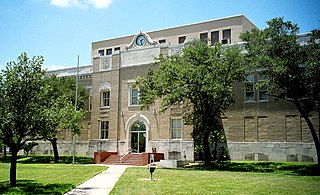
San Patricio County is located in the U.S. state of Texas. As of the 2020 census, its population was 68,755. Its county seat is Sinton. San Patricio County is part of the Corpus Christi metropolitan statistical area.
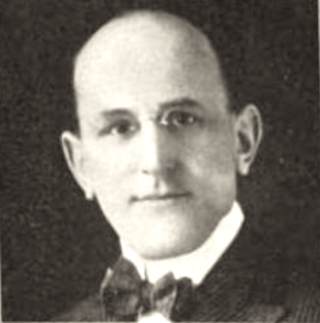
Fred Fisher was a German-born American songwriter and Tin Pan Alley music publisher.
Tell Taylor (aka TellienéTell Roberts;. Tell was born October 28, 1876 to Clarinda Jane Roberts and John Asbury Taylor, on a farm near the Village of Vanlue, Amanda Township, Hancock County, Ohio. He was an American traveling vaudeville performer, tenor vocalist, playwright, music publisher, composer, and lyricist who had written over 200 popular songs. His biggest hit was "Down by the Old Mill Stream" from 1910, one of the most commercially successful Tin Pan Alley publications of the era. The song was published by Tell Taylor, Inc., which he had co-founded in 1907. Taylor performed vaudeville theaters and founded a Chicago music publishing house bearing his name. His other notable songs include "He Sleeps Beneath the Soil of France," "I Love You Best of All," "If Dreams Come True," "Little Old Home in the Valley," "Rock Me to Sleep in the Old Rocking Chair," "Some Day," and "When the Maple Leaves Were Falling." Taylor also wrote the Broadway comedies Tiger Lillee and In New York Town.

Hollywood and Vine, the intersection of Hollywood Boulevard and Vine Street in Hollywood, California, became known in the 1920s for its concentration of radio and movie-related businesses. The Hollywood Walk of Fame is centered on the intersection.

In American theater, summer stock theater is a theater that presents stage productions only in the summer. The name combines the season with the tradition of staging shows by a resident company, reusing stock scenery and costumes. Summer stock theaters frequently take advantage of seasonal weather by having their productions outdoors, under tents set up temporarily for their use, or in barns.

Helen Morgan was an American singer and actress who worked in films and on the stage. A quintessential torch singer, she made a big splash in the Chicago club scene in the 1920s. She starred as Julie LaVerne in the original Broadway production of Hammerstein and Kern's musical Show Boat in 1927, as well as in the 1932 Broadway revival of the musical, and appeared in two film adaptations, a part-talkie made in 1929 and a full-sound version made in 1936, becoming firmly associated with the role. She suffered from bouts of alcoholism, and despite her notable success in the title role of another Hammerstein and Kern's Broadway musical, Sweet Adeline (1929), her stage career was relatively short. Helen Morgan died of cirrhosis of the liver at the age of 41. She was portrayed by Polly Bergen in the Playhouse 90 drama The Helen Morgan Story and by Ann Blyth in the 1957 biopic based on the television drama.

Sherman Howard is an American actor. He is best known for his performance as the zombie Bub in George A. Romero's Day of the Dead (1985) and Lex Luthor on Superboy (1990–92). He also voiced Derek Powers in Batman Beyond (1999–2001).
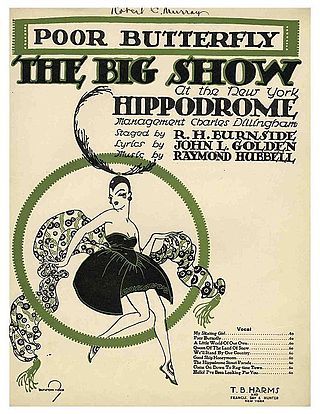
John Raymond Hubbell was an American writer, composer and lyricist. He is best known for the popular song, "Poor Butterfly".

A Stubborn Cinderella is a musical in three acts with music by Joseph E. Howard, and book and lyrics co-written by William M. Hough and Frank R. Adams. A reinvention of the classic Cinderella folk tale, the plot is a spoof on American college life during the early 20th century. The musical is set at a fictional Columbus University in the United States, a Mountain Wilderness near the Mexican Border, and at a beach in Coronado, California.

Clark Street is a north–south street in Chicago, Illinois that runs close to the shore of Lake Michigan from the northern city boundary with Evanston, to 2200 South in the city street numbering system. At its northern end, Clark Street is at 1800 West; however the street runs diagonally through the Chicago grid for about 8 miles (13 km) to North Avenue and then runs at 100 West for the rest of its course south to Cermak Road. It is also seen in Riverdale beyond 127th street across the Calumet River, along with other nearby streets that ended just south of the Loop. The major length of Clark Street runs a total of 98 blocks.

The Allerton Hotel for Women, today known as Hotel 57, is a hotel located at 130 East 57th Street in the New York City borough of Manhattan. It is a seventeen-story brick, limestone, and terra cotta building designed by Arthur Loomis Harmon in 1920. It was built on the southwest corner of Lexington Avenue and 57th Street by the Allerton House Company at a cost of $700,000. It originally had stores on its ground floor. The hotel intended to accommodate six hundred business and professional women and also shelter young girls. When completed in 1923, the Allerton Hotel had room for four hundred tenants. Its occupancy was filled prior to completion and there was a long waiting list. After opening it was so popular that another establishment of its kind was anticipated.
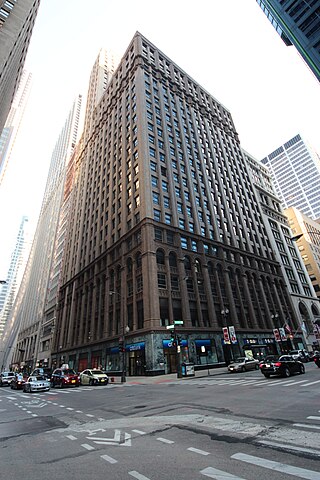
11 South LaSalle Street Building or Eleven South LaSalle Street Building is a Chicago Landmark building that is listed on the National Register of Historic Places and that is located at 11 South LaSalle Street in the Loop community area of Chicago, Illinois, United States. This address is located on the southeast corner of LaSalle and Madison Street in Cook County, Illinois, across the Madison Street from the One North LaSalle Building. The building sits on a site of a former Roanoke building that once served as a National Weather Service Weather Forecast official climate site and replaced Major Block 1 after the Great Chicago Fire. The current building has incorporated the frontage of other buildings east of the original site of Major Block 1.

The La Salle Hotel was a historic hotel located on the northwest corner of La Salle Street and Madison Street in the Chicago Loop community area of Chicago, Illinois, United States. It was designed by Holabird & Roche and opened in 1909. After a major fire in 1946, the hotel was refurbished and reopened in 1947. It closed in 1976 and was demolished for construction of an office building.
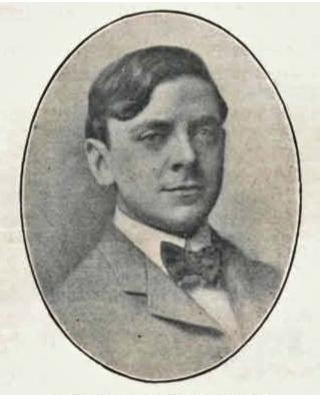
Addison Burkhardt was a librettist and lyricist from about 1903 to 1922 and a Hollywood script and scenario writer thereafter.
James Garfield Ellis was an American violinist, silent film theater pioneer, composer, lyricist, and music publisher.
The Cotton Club Boys were African American chorus line entertainers who, from 1934, performed class act dance routines in musical revues produced by the Cotton Club until 1940, when the club closed, then as part of Cab Calloway's revue on tour through 1942.

Lothar Wallerstein was Czech-born musician and conductor of Austrian descent who became a U.S citizen in 1945, four years before his death. He was a stage manager at the Vienna State Opera, Salzburg Festival and Metropolitan Opera. He became stage director of the Vienna State Opera in 1926, where in 1931 he collaborated with Richard Strauss in re-writing Mozart’s Idomeneo. He emigrated to New York City in 1940 to evade the rise of Nazi influences in Austria, followed by the German annexation of that country, and the subsequent invasion of the Netherlands where he had sought refuge. At the end of World War II, he returned to Europe, where he taught acting classes for singers, and founded an opera school in The Hague, Netherlands.

The 54th Illinois General Assembly met from 1925 to 1927. Fred E. Sterling of Rockford was the Lieutenant Governor of Illinois and thus ex officio President of the Senate. Richard J. Barr of Joliet was President pro tempore of the Senate. Robert Scholes of Peoria was the Speaker of the House of Representatives.

The 55th Illinois General Assembly met from 1927 to 1929. Fred E. Sterling of Rockford was the Lieutenant Governor of Illinois and thus ex officio President of the Senate. Richard J. Barr of Joliet was President pro tempore of the Senate. Robert Scholes of Peoria was the Speaker of the House of Representatives.

U.S. National Ski Jumping Championships in the winter sport of ski jumping are decided annually in the United States since 1905, except for the years 1919, 1943–1945 and 2020.

















